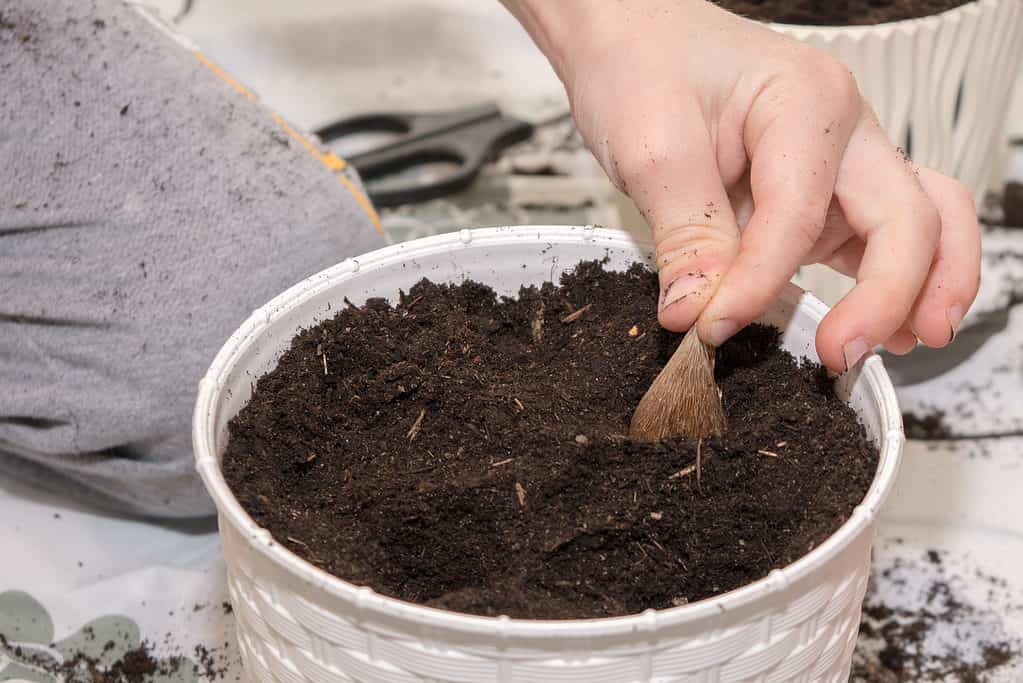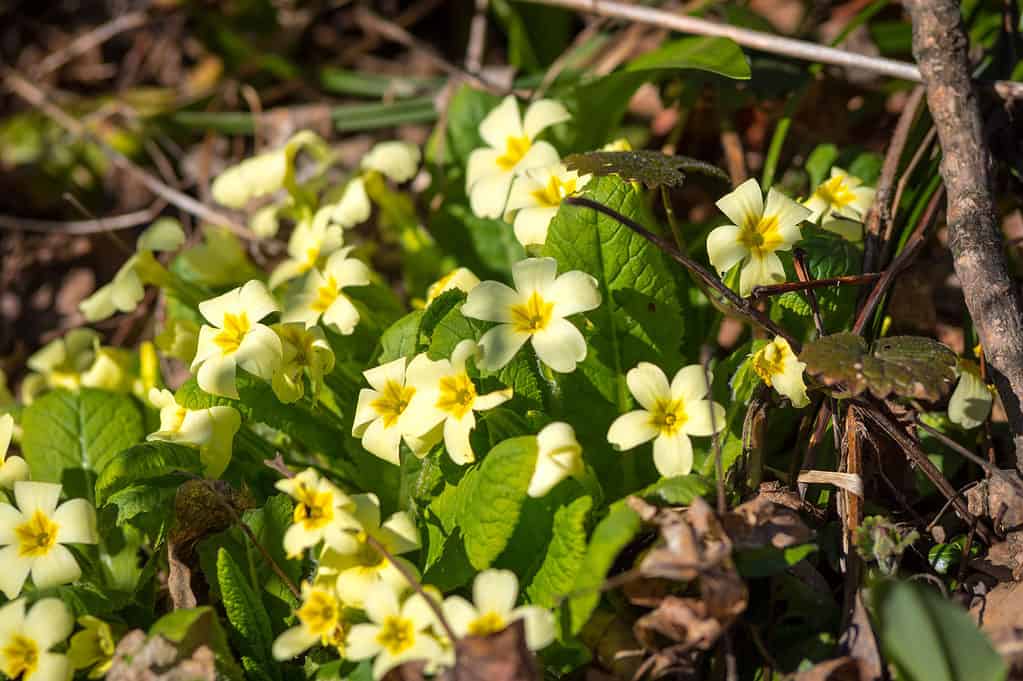Gardeners and florists around the world seek out freesias for their uniquely fragrant and vividly colorful flowers. These warm-weather plants are relatively flexible regarding their growing conditions. They can grow indoors or outdoors, in containers, or garden beds. When cared for well, they produce a good quantity of blooms per stem and make great bouquets or cut flowers. With simple care requirements and many cultivars that offer a wide range of flower colors, Freesia bulbs may be a good planting choice to brighten up your home and garden.
| Botanical Name | Freesia sp. |
| Sunlight | Prefer full sun but will grow in partial sun and light shade. |
| Water | Soil should be kept moist throughout the growing season. Taper off the water as flowers fade. |
| Soil Conditions | Very well-draining, sand- or stone-heavy. Fertile and rich in organic matter. |
| Hardiness | Winter is hardy and perennial in USDA Zones 9 and 10. Grown as annuals indoors or outdoors in lower Zones, or stored indoors over winter. |
| Beginner Friendly? | Yes. Freesias are generally durable plants with simple care requirements. |
| Special Considerations | Because of their flower quantity relative to their height, plants may need staking to remain upright during the growing season. |
What Are Freesia Bulbs?
The genus Freesia is part of the iris family or Iridaceae. It consists of around 16 species of flowering plants that are native to the south of Africa. They are durable plants that flower during the cooler, rainier winter periods of their native range. They recede into dormancy underground as the rains slow down in the late spring and summer.
Individuals of these species grow from a corm. It is the plant’s nutrient storage organ and is a modified stem tissue. Throughout the growing season, Freesia plants make and store starchy nutrients in their corms. They then use these to sustain them through their dormancy period and to produce new growth as the weather begins to cool. Freesia corms are conical and small. They measure, on average, only about an inch in length. A papery outer layer, or a tunic, covers it. This outer layer is made up of older leaves from the previous year’s growth. It helps protect the corm while it lies dormant.

When cared for well,
Freesiaproduces a good quantity of blooms per stem and makes great bouquets or cut flowers.
©iStock.com/bea8476
How to Care for Your Freesia Bulbs
While freesias are generally hardy and simple to care for during their growing season, you can ensure that your plants have all they need by following the care guidelines below. Because of the number of flowers produced per stem, you will likely need to place support stakes in the ground near your corms at the time of planting.
Planting
When choosing corms to purchase, seek out the largest ones. Larger corms contain greater amounts of stored nutrients and therefore will produce, on average, larger and more robust plants. Once you have placed them in the soil, Freesia corms will generally produce flowers within 2 to 3 months. To ensure a continuous show of blooms throughout the season, gardeners generally choose to stagger their bulbs. They allow for about a week between plantings.
The planting season for freesias depends primarily upon the location of the gardener. In USDA Zones 9 and 10, corms are winter hardy and can be planted outdoors in the fall for the production of winter flowers. In cooler areas, Zones 8 and below, freesias are generally grown as annuals. They are planted in the springtime so that their flowers appear in the summer. If you choose to plant outdoors, be sure to do so only after all risk of frost has passed.

Larger
Freesiacorms contain greater amounts of stored nutrients and therefore will produce, on average, larger and more robust plants.
©iStock.com/Ihor Hrelyuk
Sunlight
Like most flowering bulbs and corms, Freesia “bulbs” prefer to grow in full sun but will grow in partial shade as well. This can be capitalized upon to help keep them cool in areas where temperatures remain higher for longer. Maintaining cooler soil temperatures is important. Overall growth may be stunted and flowering may be delayed if your Freesia plants overheat. After all, they bloom over the fall and winter in their native range.
If you are growing your freesias in containers indoors, then be sure to place them in a sunny area of your house that remains between 60-70 degrees Fahrenheit over the day. While temperatures are easier to control indoors, providing adequate sunlight can be a challenge in some scenarios. Make sure your plants receive 6-8 hours of strong sunlight per day.
Water
In their native range, freesias begin to emerge from their corms during the autumn months when temperatures begin to cool and rains become more consistent. From the time they send up their first leaf and stem growth, they need plenty of water — to keep their soil moist throughout the growing season. After they have produced their flowers, watering should be tapered off to mimic the seasonal shift of their native environment. At this point, the foliage should be allowed to turn yellow and die back.
Soil Conditions
Freesias require fertile, well-draining soils. Although they begin to crop up during their native rainy season, care must be taken to avoid wet soil and standing water. Soil that does not drain well enough and remains overly wet for extended periods can encourage an anaerobic environment where conditions are ripe for corm rot and root rot.
Pests and Disease
Lack of sunlight, over- or under-watering, and improper soil conditions can weaken your plants’ defenses against pests and disease. Typical garden insects such as aphids, thrips, and slugs are the most likely to prey on your freesias.
Lack of sunlight and watering practices that allow moisture to stand on leaf surfaces can leave your plants susceptible to bacterial leaf spots. This bacterial infection causes dark, necrotic spots to appear on leaves. Dispose of infected parts of the plant, handling them as minimally as possible, and washing your hands before interacting with your plants again. If the infection continues to spread, the best practice for control is to entirely dispose of the infected plant or plants.

Like most flowering bulbs and corms,
Freesiaprefers to grow in full sun.
©iStock.com/Wirestock
End-Of-Season Care
At the end of the growing season, your Freesia plants will begin to die back and retreat underground into their corms. As your plants head toward dormancy you may wish to take additional steps to increase your Freesia population or to store them indoors to help them through the winter.
Propagation
If you are familiar with growing bulbs and corms already, then it should come as no surprise that freesia “bulbs” will propagate themselves when grown in the right conditions. At the end of the growing season, when you dig up your Freesia corms for winter storage, you will probably notice that they have produced several small copies of themselves around their root plates. These copies, called offsets or cormlets, can be carefully separated from the parent corm and planted or stored for planting the following season.
It is important to note that your new offsets will take multiple seasons of growth to begin producing flowers. For this reason, especially in climate zones where freesias cannot easily be grown as perennials, many gardeners choose to forgo propagation and instead purchase mature Freesia corms.
Storage
Gardeners who live in areas where freesias are unable to survive winter temperatures will generally grow them as annuals only, purchasing new bulbs to plant at the return of spring. However, if you are attached to your plants and would like to re-plant them, you can store them indoors over the winter.
Once the foliage has wilted and yellowed, carefully lift your Freesia “bulbs” from the soil using a garden fork and gently remove large clumps of soil. Once free of excess soil, allow your bulbs to dry out over a week or two and store them dry in a breathable container. Be sure to separate them in such a way that they do not directly touch each other to prevent the spread of decay if one begins to rot.
You should store Freesia corms in an area that is between 77 and 86 degrees Fahrenheit to mimic summer temperatures in the plant’s native range. Take care to group and label bulbs of different species or cultivars, as each may require slightly different care once planted.
The photo featured at the top of this post is © iStock.com/Collinswood Images
Sources
- NC State Extension, Available here: https://plants.ces.ncsu.edu/plants/freesia
- University of Florida IFAS, Available here: https://blogs.ifas.ufl.edu/nassauco/2017/06/21/q-can-plant-freesia-ground-northeast-florida
- Missouri Botanical Garden, Available here: https://www.missouribotanicalgarden.org/PlantFinder/PlantFinderDetails.aspx?taxonid=264594
- Mississippi State University Extension, Available here: https://extension.msstate.edu/publications/freesia-freesia-%C3%97-hybrida-for-the-farmer-florist
- Michigan State University Plant & Pest Diagnostics, Available here: https://www.canr.msu.edu/resources/bacterial-leaf-spot
- The Jepson Herbarium, Available here: https://ucjeps.berkeley.edu/eflora/eflora_display.php?tid=9431
- Wisconsin Horticulture, Available here: https://hort.extension.wisc.edu/articles/storing-tender-bulbs-for-winter
- University of Florida IFAS Gardening Solutions, Available here: https://gardeningsolutions.ifas.ufl.edu/plants/ornamentals/is-this-a-bulb.html
Thank you for reading! Have some feedback for us? Contact the AZ Animals editorial team.






